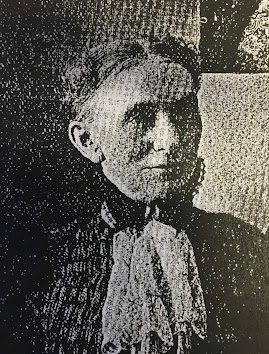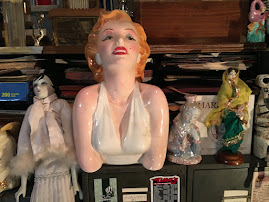Vicki and Peter
(circa 1948)
Dear George,
My dad, Vic L., was an
excellent photographer. In the
early 2000’s my brother Peter transformed many of Vic’s family photos into
postcards. Peter’s multi-year project is the source of most of the images
below. Each week I post a new
selection of “Vic’s Photos” on this blog’s righthand column. Because these individual photos don’t
get saved, I’ve been reproducing batches of them in a series of archives. This is No. 10. An interested reader can locate earlier
archives by clicking on “Archives” in the “Labels” section of the right-hand
column and scrolling down. There
are lots of rich memories of our childhood and family and friends in Menominee.
Love,
Dave
My maternal grandfather Guy
Cramer, a retired insurance executive, moved to Menominee from Omaha several
years after his wife Nora died. He
lived up the street from us at 914 Ogden Avenue, and he also built a large
summer cottage on a prime location on the Menominee River about a mile out of
town. The house was set in a grove
of Norway pines. This is an early
photo, and the willow tree, evergreens, and birches that later graced the front
lawn aren’t there yet. Guy died in
1942. Our family moved into the
house in 1946 when my dad returned from the war, and we siblings spent our
childhood and teenage years there.
While I sometimes felt separated from friends in town, our river house
was, in many respects, an idyllic location in which to grow up.
Here are my mom and dad,
Doris and Vic, decked out in their winter finery outside our dining room
window. Because my dad was the
family photographer, we have few pictures of Vic and Doris together. This is a particularly pleasing one.

Here’s my brother Steve,
maybe a year old, with our mom.
Steve grew up to have an affectionate, joking connection with
Doris. As the firstborn, I was a
lot more uptight as a young person, but Steve, the second born child, developed
much more of our mother’s propensity for fun and good times. His cheery nature served us all well.
Xmas was a big occasion in
our household. Here I’m about six
which would mean we lived in town at our house on Sheridan Road. While they weren’t extravagant, my
parents always made sure that Santa delivered presents we would enjoy.
Here’s my sister Vicki and
myself in front of the family Xmas tree in December, 1947. Vicki was born on February 24th of that
year, so she’s about 10 months old.
I can’t remember very much about any of my siblings as infants, except
that Vicki’s birth was a huge event in our family. Given three older boys in a row, our parents were thrilled
to have a baby girl.
This is Vicki’s first
birthday. I was ten years older
than Vicki, so I probably thought she was cute, but not yet the sort of sibling
with whom you could play Chinese checkers or have an acorn fight. My most vivid memory of Vicki’s infancy
has to do with a day that my mother decided I should help more with child care
and gave me a diaper-changing task.
I was mortified, and when my mother turned her head, I ran out the dining
room door and disappeared into the back yard. I wandered around the property across the road for the rest
of the day, and a large horse chased me across the field. I thought it was better to be trampled
to death by a horse than to change a baby’s diapers.
Here are kids playing
softball in our front yard in the winter.
I’m not certain, but my best guess is that Terry O’Hara is at bat, I’m
pitching, and my brother Steve is waiting for his turn to hit. Some favorite family trees are in the
photo -- Norway pines at the left, birches on the riverbank, the large spruce
in the center of the yard, and the willow tree,at the right, by far the best
tree for climbing. Our front yard
was our sports stadium: baseball, football, golf, archery, rifle shooting,
track and field, etc. We played
basketball in back of the house at the garage.
Terry O’Hara is a regular
reader of this blog, so she may be surprised to run across her portrait as a
teenager. The O’Hara’s were our
closest family friends, and we’d get together regularly at their house on the
Green Bay shore or at our house on the river. Terry, the oldest kid in their family, was two years younger
than me; Michael Dennis, a year younger than my brother Steve; Kiera, the same
age as my sister Vicki; and Patrick Sean, the youngest of all the kids in the
two families. Terry was always
full of energy and enthusiasm. We
did lots of swimming, boating, sports, hiking in the forest, fireplace fires,
movie-going, trick-or-treating on Halloween, and childhood pranks.
Dooley (left) and Ann were
the daughters of Jean and Margaret Worth, close friends of my parents, and we
all grew up together. The Worths
had a hunting camp at Cedar River which was a gathering place for adults and
kids in this friendship group, and we had many enjoyable times at the camp and
in the surrounding primeval forest.
Vicki (left) and Kiera O’Hara
were age-mates and grew up together as BFF’s. Kiera was born on the Fourth of July and was nicknamed
Firecracker. Vicki got most of her
religious exposure from going to church with Kiera and her family. The girls went to the University of
Michigan and were freshmen together during my last year of graduate school
there.
Here’s my teenage sister
Vicki with the Popkey’s St. Bernard from across the road. The Popkey family, which included four boys and a girl (Ross, Bill, John, Dan, and Dolly), moved to Riverside Boulevard in the early 1950s, and the
younger boys would frequently bring their St. Bernard pet over to visit our house. The dog's name was Manfred, after the dog in the Tom Terrific cartoon show. He
was the largest dog we’d ever seen.
Here are my three siblings
-- Vicki, Peter, and Steve -- somewhere in Menominee County in midwinter. This is about as hilly as it gets near
Menominee, and Vicki’s holding an aluminum disc for sledding. Peter has the family BB gun, and Steve
has a pistol for target shooting.
I'm going to guess that Steve is about 16, which would make it
1957. I was away at college.
This is my friend Bob A. and
myself in the late 1950’s. We’d
bee high school classmates. Bob
was in college at one of Michigan’s state universities while Katja and I were
students at Antioch. Bob arranged
for my dad to purchase a 1952 Buick from his uncle which I drove back and forth
between Yellow Springs and Menominee, Philadelphia, New York, and even San
Francisco. We’re still good
friends with Bob and his wife Lois, though we only get together every few years
in Menominee.
I’m opening a Christmas
present in our living room, probably about my junior or senior year of high
school. Our family’s Hammond Chord
Organ is in the background. Vicki
and I were the most interested in playing the chord organ, and Katja and I
still have it in our second floor elevator room. One of my dad’s oil paintings is on the wall.
Here's our mom, Doris, with
her four kids in front of the living room fireplace at our home. From the left: myself (approx. 18 years
old), Peter (10), Steve (14), and Vicki (8). I think that's our new family television set. I first saw television in Menominee at
my friend Sally H's house as a ninth-grader. Our family was just about the last in our entire circle of
acquaintances to get this new-fangled gadget. I remember sitting on the living room couch and watching
Minneapolis Laker basketball games, starring George Mikan.
Here are Marty and Jackie Burke,
along with my dad and mom (at the right).
I’d guess they are off on a trip together. The Burke’s oldest son Skipper was my best childhood chum,
and we were all sad when their family moved from Menominee to Minneapolis when
Skipper and I were in fifth or sixth grade.
My father and his friends
were members of the World War II generation. He’s pictured here with Mike and Jean O’Hara and Pat
Steffke. Vic was in the Navy, Mike
in the Marines, and Pat in the Army.
There was lots of joking by the veterans about which branch of the
military was the most vital, but in truth they all had great respect for one
another.
This is my dad’s friend and
law partner, Dick Sawyer, with one of his kids (Peter guessed it was their son
Chip). The Sawyer’s lived in a
house on State Street, and we lived two blocks away on Sheridan Road. Dick had a hunting camp in Menominee
County, and I was invited to come along for a pre-dawn duck hunting expedition
as a teenager.
My sister Vicki looks
pretty young to be smoking a cigarette, especially given that her anti-smoking
dad is taking the picture. I'm
going to guess that she's a college student in her first year at the University
of Michigan in 1965. We all took
up smoking as college students, if not before. It was a destructive habit, but it seemed like everybody
smoked in those days. It took me
twenty years to quit, my siblings even more.
Uncle Kent was my dad’s
younger brother (and a twin brother of Karl). He was in the Army in World War II and participated in the
invasion of France where he was awarded a Silver Medal. Kent came back from the war and owned
and operated my grandfather’s drugstore on Electric Square in Menominee, as
well as serving as State Commander of the American Legion and an elected member
of the Michigan House of Representatives.
Because I was a habitué of the drugstore’s comic book department, I had
more frequent contact with Uncle Kent during my childhood than with any other
member of our extended family.
G-mail Comments
-Gayle C-L
(1-28): David, Very Cool! Great Photos
and great emories.. Love all the photos and especially Love the photo of
your mom and dad..
Thx for
sharing.!!! Hope your New Year is going well... And your family is
well too.. Pl keep the letters to
George coming.. Lots of love to
all. G :)




















































































































































































































